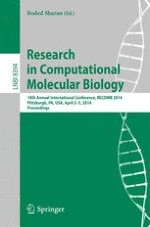2014 | Buch
Research in Computational Molecular Biology
18th Annual International Conference, RECOMB 2014, Pittsburgh, PA, USA, April 2-5, 2014, Proceedings
herausgegeben von: Roded Sharan
Verlag: Springer International Publishing
Buchreihe : Lecture Notes in Computer Science
